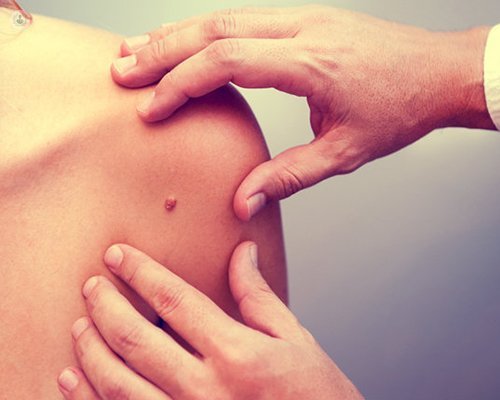Cancer and your skin: why it’s important to check yourself out
Written by:Everyone has blemishes on their skin and these increase in number as we get older. The challenge is to know which sort of lesion might represent a skin cancer.
Most skin cancers are the result of excessive sun exposure in the past and mainly affect people over the age of 50. The exception is malignant melanoma which can affect younger adults: particularly those who have taken frequent holidays abroad. The great majority of moles develop in children and teenagers, and are benign. Melanoma is a cancerous mole that can spread beyond the skin and prove fatal. So adults of any age who develop a new mole should take it seriously.
Dermatologists often stress how important it is for you to check your skin, looking for changes or any peculiarities that might need investigating. It’s recommended that you do this regularly, and if you have doubts, get in contact with a specialist to arrange an appointment.

What changes are suspicious of melanoma?
Any pigmented lesion that:
- have changed in size, colour, or shape
- look different from other moles
- is asymmetrical
- shows different shades or different colours
- is bigger than 6mm in size
- has itched or bled
- has an eroded or scabbed surface
Remember these changes only indicate the need for further investigation. There are several types of pigmented lesion that can show some of the above features but are completely benign: for example pigmented seborrhoeic warts. However, any lesion that has bled or become scabbed should be looked at urgently by a professional. The thickness of the melanoma at surgery determines the patient's chances of survival, so early diagnosis and removal is essential.
Who is at risk from developing melanoma?
Those at greatest risk from developing skin cancer are those who:
- are fair-skinned
- burn in the sun easily
- experienced sunburn quite frequently as a child
- spend a lot of time in the sun, either through work, or leisure
- spend brief periods of time in the sun when its rays are at their most intense, for example when going on holiday or sunbathing
- use sunbeds, either with UVA light or artificial sunlight
- have more than 50 moles or more than 11 on one limb
- have a family history of melanoma

To reduce the risk of skin cancer, dermatologists advise the following:
- avoid getting sunburnt
- use sunscreen, particularly in children who are fair-skinned. An SPF of 15 will reduce sun exposure by more than 90%
- avoid the sun when its rays are strongest (typically between 12pm and 4pm)
- re-apply sunscreen after swimming and towelling
- protect your face and eyes with a hat and sunglasses
- avoid the use of sunbeds
Other types of skin cancer
Apart from melanoma there are two other types of skin cancer known as non-melanoma skin cancer which account for 90% of skin cancers in the UK. The commonest is a basal cell carcinoma, and the other is a squamous cell carcinoma. Normally they arise in skin that has been damaged by chronic sun exposure over many years, and they therefore affect an older age group. In addition they are not usually pigmented. They are common in fair-skinned individuals, particularly people who have lived or worked abroad or spent long periods of time outdoors or sunbathing They normally present as a slowly growing lesion that becomes raised and may bleed, scab or ulcerate. These features indicate the need for a professional opinion.
Most patients with non-melanoma skin cancer also exhibit precursor or precancerous lesions known as solar keratoses which can be recognised as flat or slightly raised lesions which feel rough or gritty when touched. They are often multiple and usually located on the face or back of the hands, though in men who have lost their hair, the scalp is another common location. They can be treated by freezing or with creams. Surgery is only needed if there is doubt about the diagnosis or the possibility of invasive change.
Conclusion
It is important to diagnose skin cancer early. The most dangerous type is malignant melanoma which can present throughout adult life. Fortunately it is also the rarest. The above article should help to identify those individuals most at risk and raise awareness of which lesions require further investigation. If in doubt, consult a specialist.



